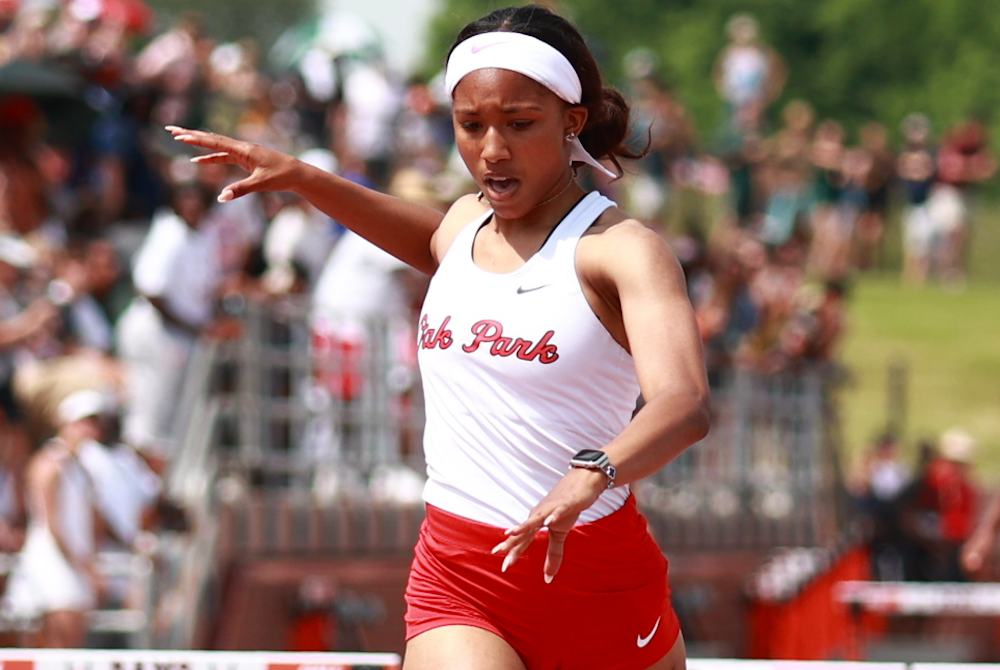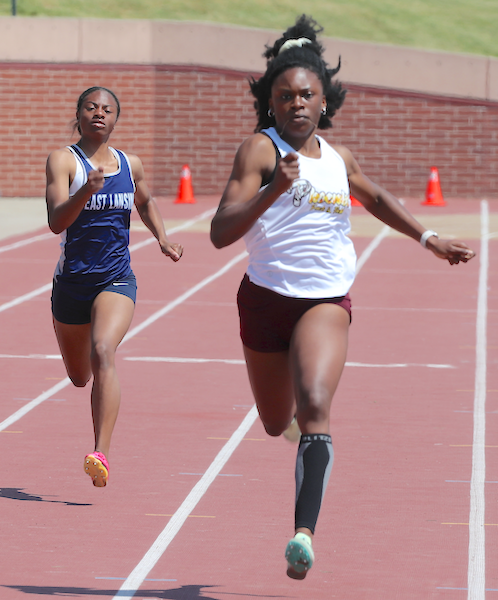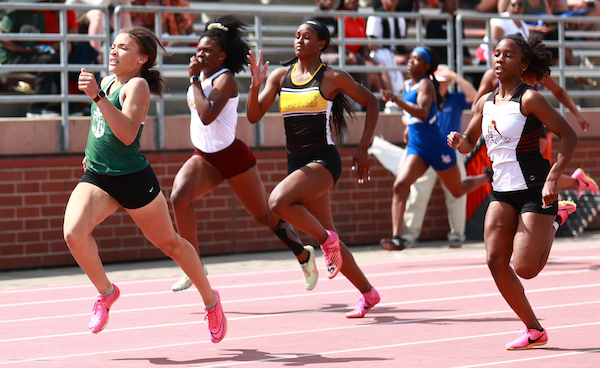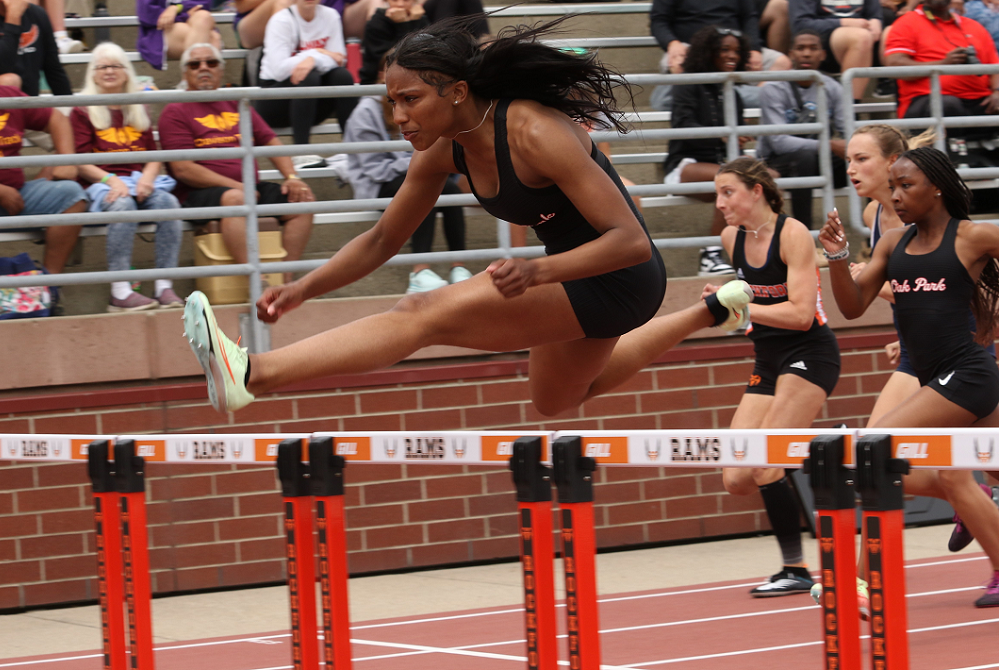
Oak Park Girls Hurdle Competition Again to Regain LPD1 Championship
By
Keith Dunlap
Special for MHSAA.com
June 3, 2023
ROCKFORD – For the fourth time in five seasons Saturday, Oak Park’s girls captured the Lower Peninsula Division 1 team title – this time with a meet-best 80 points at Rockford High School.
Last season’s champion Detroit Renaissance was second with 58 points, while Ann Arbor Pioneer was third at 56.
The Knights – runners-up a year ago – won again mainly thanks to their dominance in the hurdles. Senior Nonah Waldron won the 100 and 300 hurdles, but also Morgan Roundtree was third in the 100 (13.86) and second in the 300 (41.54) and Carrie VanNoy was fourth in both the 100 (14.18) and 300 (44.11).
Waldon said the team’s success was all about pushing each other the best they could in practice every day.
“It takes maturity to understand that you all can be great together,” Waldron said. “It took a lot of love for each other to be the best we can be.”
 The Knights also were second in the 400 relay (47.71) and 800 relay (1:38.21), and third in the 1,600 relay (3:55.27).
The Knights also were second in the 400 relay (47.71) and 800 relay (1:38.21), and third in the 1,600 relay (3:55.27).
“I think that dealing with losing and some adversity helps you grow,” Oak Park coach Brandon Jiles said. “I think the kids used the experience from last year to catapult them this year. We know it’s a points game. We know there are no style points in team championships. We spread the kids out to do what we needed to do. We’re not a depth team, but a quality team. They showed out, and I’m happy.”
Waldron won the 100 hurdles in a time of 13.56 before really putting on a show in the 300 hurdles. She won that event in a time of 40.37, which was the second-fast time in that event in the nation thus far this year. Waldron, who will run in college at USC, also won both hurdles events two years ago and won the 100 hurdles last year, but had a mishap that cost her last year’s title in the 300.
“Last year, I fell and tore my ankle,” she said. “That did motivate (me) a lot more than before. It made me want it more.”
If it wasn’t evident that Renaissance sophomore Jayla Dace might be the state’s next big sprinting star already, she established that on the biggest stage.
Dace won the 100-meter dash in a time of 11.90 and was a part of winning 400 and 800 relay teams. Dace also took third in the 200-meter dash in a time of 24.56.
“The starting gun is a horn, so I’m not really used to that,” Dace said of her strategy in the 100. “I had to really adapt quickly and to make sure I wasn’t the last person to get out of the blocks. Once you see people in the 100 ahead of you, it’s over. I just had to make sure when I started the race that I really didn’t see anybody.”
In the relays, Dace ran the second leg in the 400 and the first leg in the 800.
 “I’m just happy we were able to execute,” Dace said.
“I’m just happy we were able to execute,” Dace said.
Saturday was quite an inauguration into the pressure of a high school state meet for West Bloomfield freshman Kamryn Tatum. But she performed like a veteran, winning the 400 in a time of 55.74 and the 200 in a time of 24.10.
“I’ve been at big meets so I know how to deal with quite a bit of pressure, but I was still nervous because it was my first high school (Finals),” Tatum said. “I just wanted to run until the end of the line.”
Ann Arbor Pioneer junior Rachel Forsyth won the 800 (2:09.96) and 1,600 (4:44.22), and East Lansing senior Anna Delgado finished first in the 3,200 (10:33.87). Forsyth also was part of Pioneer’s winning 3,200 relay (9:01.19), and Detroit Cass Tech won the 1,600 relay (3:52.82) by 12 hundredths of a second ahead of Renaissance.
Howell senior Sophie Daugard was first in shot put (41-7), Allen Park junior Abigail Russell first in discus (148-7½), and Grand Rapids Forest Hills Central junior Brooke Bowers won pole vault (12-3). Farmington Hills Mercy junior Milena Chevallier won high jump (5-11), and Rockford senior Maya Anderson was champion in the long jump (18-6½). Flushing sophomore Ally Ingrahm competed in the adaptive 100 (42.81).
PHOTOS (Top) Oak Park's Nonah Waldron crosses the finish line first in the 100 hurdles Saturday. (Middle) Renaissance's Jayla Dace, right, charges toward the finish. (Below) West Bloomfield's Kamryn Tatum, far left, leads the 200. (Photos by Jamie McNinch [top photo] and Carter Sherline/RunMichigan.com.)

Preview: LP Girls Finals Welcome Back Stars, Hopefuls Ready to Join Them
By
Geoff Kimmerly
MHSAA.com senior editor
June 1, 2023
The MHSAA Lower Peninsula Girls Track & Field Finals have showcased plenty of stars over the years, and Saturday’s meets will celebrate more with returning competitors owning a combined 22 individual championships won over the last three seasons.
But this season’s field also sticks out because of several hopefuls who appear on the verge of greatness as well, many of whom we highlight below.
All four LP Finals will again be contested at Grand Rapids-area schools, with pole vault and long jump beginning at 9 a.m., race semifinals and the 3,200 relay at 10 a.m. and the rest of the running finals starting at noon. Tickets cost $11 and are available digitally only via GoFan.
MHSAA.tv will live-stream all four meets beginning at 10 a.m., viewable with subscription.
Following is a glance at team contenders and individuals to watch in all four divisions:
LP Division 1 at Rockford
Team forecast: After winning three straight LPD1 team titles, Oak Park finished second last season to Detroit Renaissance – which had finished second twice in a row before claiming its first title since 2007. Those two are the likely favorites again, and Renaissance won their Regional matchup two weeks ago 135½-108 as they combined to post the top two times in three relays from all LPD1 Regionals. Oak Park continues to surge with one of the top hurdler groups in recent memory, while Renaissance’s depth in elite sprinters has been unmatched despite graduating one of the all-time greats last spring. All of that said, keep an eye on Ann Arbor Huron too. The River Rats finished third last season, are paced by an elite sprinter and have the potential to pick up points in a variety of events.
Jayla Dace, Detroit Renaissance sophomore: After qualifying in the 200 and running on the winning 800 relay last season, Dace enters this weekend after running the fastest 100 (11.91) and fourth-fastest 200 (24.95) at LPD1 Regionals while also slated to run on two contending relays.
Arianne Olson, Holland West Ottawa senior: Last season’s 3,200 champion and 1,600 runner-up enters with the third-fastest 3,200 (10:48.40) from LPD1 Regionals and also again will run the 1,600 and on a contending relay.
Mackenzie Robinson, Ann Arbor Huron senior: She finished second in the 100 and 200 last season and ran on champion and runner-up relays, and she could be in for an even bigger finish after posting the second-fastest LPD1 Regional 100 (12.11) and 200 (24.74) and running on the third-fastest 400 relay two weeks ago.
Morgan Roundtree, Oak Park junior: Her sophomore-year Finals included a 300 hurdles title and runner-up finishes in the 100 hurdles and 800 relay. She enters this weekend with the fastest LPD1 Regional time in the 300 (41.86), third-fastest in the 100 hurdles (14.14) and running on two contending relays again.
Abigail Russell, Allen Park junior: She swept the throws as a sophomore and could be in line to do the same this weekend with the top LPD1 Regional throw in discus (148-3) by more than 12 feet and the second-farthest shot put (42-5) behind only Howell senior standout Sophie Daugard.
Kamryn Tatum, West Bloomfield freshman: She enters her first Finals having run the fastest 200 (24.70) and 400 (56.08) times in any LPD1 Regional, with those times fast enough to have finished third in those races at last year’s Finals.
Nonah Waldron, Oak Park senior: She’s finishing a career that’s included the last two 100 hurdles championships and a 300 hurdles title as a sophomore. She enters this weekend with the fastest LPD1 Regional time in the 100 hurdles (13.61), second-fastest to Roundtree in the 300 (42.70) and likely to run on the same two contending relays as that teammate.
LP Division 2 at Ada Forest Hills Eastern
Team forecast: The last five Finals have seen five schools win Division 2 once and three more schools finish second at least once. East Grand Rapids nearly doubled up the field last year, however, and power in distance races and relays could have the Pioneers on track again. New Boston Huron was fourth last season behind the scoring of Elizabeth Anderson and could follow her into contention, and Dearborn Divine Child has qualifiers in all but pole vault and a pair of relays expected to do exceptionally well.
Elizabeth Anderson, New Boston Huron senior: She won the 200 and 400 and was runner-up in the 100 last season to score 28 of her team’s 29 points, and she could take that over 30 this weekend entering with the fastest LPD2 Regional times in the 200 (24.93) and 400 (56.62), the second-fastest in the 100 (12.34) and as part of one of the fasted 1,600 relays.
Camryn Bodine, East Grand Rapids senior: Last season’s 800 champion ran the fastest LPD2 Regional time in that race (2:13.14) two weeks ago by nearly four seconds and will also run on two contending relays after helping hers to first, second and seventh places in 2022.
Janae Hudson, Marysville junior: She could move up substantially after placing third in discus and 10th in shot put last season, coming off the top LPD2 Regional shot put (41-4½) and second-longest discus toss (125-5).
Ella Jenkins, Warren Regina senior: The reigning champion in the 300 hurdles and runner-up in the 100 hurdles ran the fastest LPD2 Regional time in the 100 hurdles (15.14) and second-fastest in the 300 (47.55).
Drew Muller, East Grand Rapids junior: The reigning 1,600 champ and 800 fifth-place finisher – and LPD2 cross country champion in the fall – ran the fastest 1,600 LPD2 Regional time (5:03.32) and fourth-fastest 800 (2:17.88) and will also run on two contending relays after hers finished first and second last year.
Keyanna O’Tey, Sturgis sophomore: She qualified for the 100 in LPD1 as a freshman and could play a starring role Saturday entering with the fastest LPD2 Regional time in the 100 (12.10), second-fastest in the 200 (25.49) and as part of two contending sprint relays.
Natalie VanOtteren, Grand Rapids Christian junior: She finished seventh in the 3,200 and ran on a runner-up relay a year ago and enters this weekend with the fastest LPD2 Regional time in the 3,200 (11:09.76) and second-fastest in the 1,600 (5:07.06).
Jordyn Wright, Tecumseh senior: The reigning pole vault champion by a foot posted the top LPD2 Regional height (11-9) two weeks ago and is expected to run two relays as well.
LP Division 3 at Kent City
Team forecast: Hart and Pewamo-Westphalia both have won two championships over the last five seasons, and Hart was first and P-W second a year ago. Hart again has the mix of sprint, distance, field event and relay standouts to finish first, and P-W has nearly the same amount and variety. But they’ll have company. Lansing Catholic has strong contenders in five races and two relays, Olivet could score big in relays, field events and hurdles; and Onsted could jump up with a handful of potential winners as well.
Ryan Finstrom, Grayling junior: Last season’s discus champion and fourth-place shot put finisher returns this weekend looking for a discus repeat after throwing the fourth-farthest LPD3 Regional toss (119-1).
Addison Hovey, Hart sophomore: She played a big role in last year’s title run with runner-up finishes in high jump and as part of the 400 relay, and she’ll return this weekend with the top LPD3 Regional time in the 100 (12.38) and top high jump (5-3) plus as part of two relays.
Heidi Newhouse, Lawton junior: The reigning high jump champion also finished just outside scoring range in the 400 last season, and she’ll enter this weekend tied for the second-best LPD3 Regional high jump (5-1) and third-fastest 400 (59.76).
Ally Olszewski, Grand Rapids West Catholic senior: She won the pole vault last season by half a foot and her 10-3 LPD3 Regional vault two weeks ago was half a foot better than the field. She also posted the fourth-best LPD3 Regional long jump (15-9½) and will run the 200 and again on the 800 relay after helping the latter to fourth place a year ago.
Madison Osterberg, Jackson Lumen Christi junior: After finishing 800 runner-up and seventh in the 1,600 a year ago, plus running on the runner-up 800 relay, Osterberg enters with the fastest LPD3 Regional times in the 1,600 (4:59.62) and 3,200 (11:01.05), the second-fastest in the 800 (2:16.56), and she will also run on a contending 3,200 relay.
Emmry Ross, Onsted sophomore: Her Finals debut included championships in the 400 and as part of the 1,600 relay and a runner-up finish as part of the 800 relay. She returns with the top LPD3 Regional times in the 400 (57.07) and 800 (2:15.03) and as part of contenders in the 800 and 3,200 relays.
Gloria Stepanovich, Benzie Central senior: The reigning long jump champion will return seeking a repeat after placing second at her Regional but only 1¼ inches off the lead.
LP Division 4 at Hudsonville
Team forecast: A close race came down to just a few points last season, with Muskegon Western Michigan Christian edging 2021 champion Mount Pleasant Sacred Heart by four. This could be close again – but with a different collection of contenders. Fowler, fourth last season, may be back in the mix with elite relays leading the way. Frankfort is back after finishing third and bolsters a strong field events group to go with relay strength. Hillsdale Academy could follow a strong distance group into contention, and Buckley should put up some points with a pair of stars. Portland St. Patrick is another interesting possibility with runners all over the meet and three contending relays.
Molly Brown, Addison sophomore: She had an impressive debut last season with two top-five relay finishes, a 10th in the 100 hurdles and fifth in the 300 hurdles. But this could be even better as she brings in the top LPD4 Regional times in the 100 hurdles (16.03) and 300 hurdles (46.82), the second-fastest in the 100 dash (12.98) and the seventh-best long jump.
Olivia Findlay, Marlette junior: Last season’s runner-up in the high jump and fifth-place finisher in the long jump is a favorite in both with the top LPD4 Regional performances in both at 5-5 and 16-11¾, respectively. She also posted the sixth-fastest 100 hurdles time (17.12) to qualify.
Aiden Harrand, Buckley junior: She’s won the 1,600 the last two seasons, the 800 last year and finished fourth in the 3,200 as well, and was the LPD4 cross country champ in the fall. Her LPD4 Regional times in the 800 (2:19.15), 1,600 (5:06.52) and 3,200 (11:26.04) all topped those lists.
Anna Plum, Mount Pleasant Sacred Heart senior: She’s the reigning champion in the 300 hurdles and was part of winning and runner-up relays as well as a qualifier in the 100 hurdles last season. She could put up plenty of points again entering with the fourth-fastest LPD4 Regional times in the 100 (13.06) and 200 (26.75) and the third-fastest in the 300 hurdles (48.46).
Megan Roberts, Hillsdale Academy senior: After missing last season’s Finals with an injury, Roberts will get another chance to build on a sophomore debut that included a relay championship, two relay runner-up finishes and a sixth place in the 800. She will run on two relays that posted the fastest LPD4 Regional times in their respective races and also the 400 after racing to an LPD4 Regional-best 59.85 two weeks ago.
Natalie Wandrie, Indian River Inland Lakes senior: She finished seventh in the shot put and 11th in the discus last season but could be set for a big finish with the top LPD4 Regional discus toss of 124-3½ and the third-longest shot put (37-3). She’ll also run a relay.
PHOTO Oak Park’s Nonah Waldron leaps a hurdle during last season’s LPD1 Finals. (Click for more from RunMichigan.com.)

